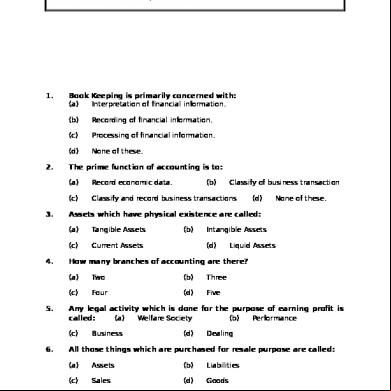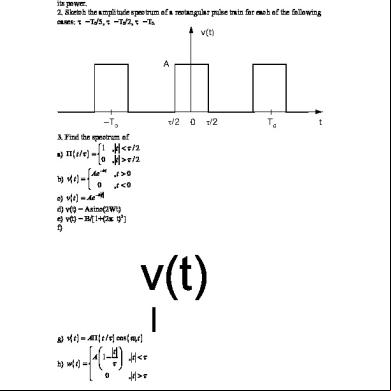Ec602 Chapter1 1j711z
This document was ed by and they confirmed that they have the permission to share it. If you are author or own the copyright of this book, please report to us by using this report form. Report 2z6p3t
Overview 5o1f4z
& View Ec602 Chapter1 as PDF for free.
More details 6z3438
- Words: 470
- Pages: 3
EC602 - COMPUTER SYSTEM DIAGNOSIS AND MAINTENANCE 1.0 PERSONAL COMPUTER COMPONENTS 1.1 Define fundamental principles of using PC 1.1.1 Define the names, purpose and characteristics of storage devices. 1.1.2 Define the names, purpose and characteristics of motherboards.(Form factor, components) 1.1.3 Define the names, purpose and characteristics of power supplies, for example: AC adapter, ATX, proprietary, voltage). 1.1.4 Define the names, purpose and characteristics of processor/Us. 1.1.5 Define the names, purpose and characteristics of memory. 1.1.6 Define the names, purpose and characteristics of display device. 1.1.7 Determine the difference between a TFT and CRT monitors. 1.1.8 Define the names, purpose and characteristics of input device. 1.1.9 Define the names, purpose and characteristics of adapter cards. 1.1.10 Define the names, purpose and characteristics of ports and cable. 1.1.11 Define the names, purpose and characteristics of cooling system. 1.1.12 Select a suitable motherboard based on the following factors: a. Type of processor b. Type of memory c. Type of graphic card slot 1.2 Do installation, configuration, optimization and upgrade of PC components 1.2.1 Define internal and external storage devices 1.2.2 Configure internal and external storage devices 1.2.3 Install display devices 1.2.4 Identify basic input and multimedia devices 1.2.5 Configure basic input and multimedia devices 1.2.6 Assemble all the components to build PC 1.3 Learn tools, diagnostic procedure and troubleshooting techniques for PC component 1.3.1 Recognize the basic aspects of troubleshooting theory. 1.3.2 Identify basic diagnostic procedure and troubleshooting techniques. 1.3.3 Recognize an issues with display, power, basic input devices, storage, memory, thermal, POST errors (e.g. BIOS, hardware). 1.3.4 Isolate an issues with display, power, basic input devices, storage, memory, thermal, POST errors (e.g. BIOS, hardware). 1.3.5 Determine the troubleshooting to check for problem (e.g. thermal issues, error codes, power, connection including cable and/or pins, compatibility, functionality, software/drivers) with component for the following: a. Motherboard b. Power supply c. Processors/Us d. Memory e. Display devices f. Input Devices g. Adapter cards 1.3.6 Recognize the names, purposes, characteristics and appropriate application of tools for example: a. BIOS and self-test b. Hard Drive self-test c. Software diagnostics test
1.4 Do preventive maintenance on PC component 1.4.1 Identify basic aspects of preventive maintenance theory for the following: a. Visual/audio inspection b. Driver/firmware updates c. Scheduling preventive maintenance d. Use of appropriate repair tools and cleaning materials e. Ensuring proper environment 1.4.2 Apply basic aspects of preventive maintenance theory. 1.4.3 Identify the common preventive maintenance techniques. 1.4.4 Recommend the easiest technique for common preventive maintenance.
Storage Devices http://my.safaribooksonline.com/book/certification/aplus/9780470486498/storage-devicespower-supplies-and-adapters/identifying_purposes_and_characteris011#X2ludGVybmFsX0h0bWxWaWV3P3htbGlkPTk3ODA0NzA0ODY0OTglMkZzdG9yYWdlX2Rld mljZXNfY29tbWFfcG93ZXJfc3VwcGxpZXNfY29tJnF1ZXJ5PQ== http://www.simulationexams.com/tutorials/aplus/essentials/personal-computercomponents1.101.htm Motherboard http://infotechnology.hubpages.com/hub/Motherboard-of-a-Computer http://www.simulationexams.com/tutorials/aplus/essentials/personal-computercomponents1.102.htm http://etutorials.org/Misc/pc+hardware/Chapter+3.+Motherboards/3.1+Motherboard+Charact eristics/ Power Supply http://my.safaribooksonline.com/book/certification/aplus/9780470486481/storage-devicespower-supplies-and-adapters/identifying_purposes_and_characteris-013
Memory http://www.studynotes.net/16_Compare_and_contrast_memory_types_characteristics_and_their_purpose Display http://www.simulationexams.com/tutorials/aplus/essentials/personal-computercomponents1.106.htm TFT vs CRT http://www.zyxware.com/articles/2008/02/02/tft-vs-crt-monitor-comparison http://www.ehow.com/list_7423807_differences-between-crt-tft-monitors.html Input Devices http://ecomputernotes.com/fundamental/input-output-and-memory/list-various-input-andoutput-devices
Adapter Card http://www.simulationexams.com/tutorials/aplus/essentials/personal-computercomponents1.108.htm Port and Cable http://www.simulationexams.com/tutorials/aplus/essentials/personal-computercomponents1.109.htm Cooling System http://en.wikipedia.org/wiki/Computer_cooling Choosing Motherboard http://www.directron.com/howtochoosmo.html http://www.ifixit.com/Wiki/Choosing_a_Motherboard http://processormatch.intel.com/ 1.2 http://www.wikihow.com/Build-a-Computer http://en.wikibooks.org/wiki/How_To_Assemble_A_Desktop_PC/Choosing_the_parts 1.3 troubleshooting http://www.careerstep.com/blog/technology-news/troubleshooting-a-problem-a-how-toapproach http://my.safaribooksonline.com/book/certification/aplus/9780470486498/troubleshootingtheory-and-preventive-maintenance/troubleshooting_theory_and_preventive_ma http://compcamp.blogspot.com/2011/10/comptia-six-step-troubleshooting.html Diagnos http://www.wikihow.com/Diagnose-a-Computer-Problem http://www.tfsnetworks.com/services/residential-services/hardware-diagnosis/ http://www.gcflearnfree.org/computerbasics/15 http://www.ifitjams.com/manual.htm
1.4 Preventive http://www.pcworld.com/article/116583/article.html http://www.ifixit.com/Wiki/Preventative_Computer_Maintenance http://www.dansdata.com/sbs16.htm http://neil1210.hubpages.com/hub/Computer-Troubleshooting-and-Prevenitive-MaintenanceTechniques http://my.safaribooksonline.com/book/certification/aplus/9780768681444/basictroubleshooting-and-preventive-maintenance-techniques/ch08 http://www.wiscocomputing.com/articles/maintenance.htm http://cuip.uchicago.edu/~jwoods/A+Book/Book/Chapter%203%20safety%20and%20Preventat ive%20Maintenance/A+03cd.htm
1.4 Do preventive maintenance on PC component 1.4.1 Identify basic aspects of preventive maintenance theory for the following: a. Visual/audio inspection b. Driver/firmware updates c. Scheduling preventive maintenance d. Use of appropriate repair tools and cleaning materials e. Ensuring proper environment 1.4.2 Apply basic aspects of preventive maintenance theory. 1.4.3 Identify the common preventive maintenance techniques. 1.4.4 Recommend the easiest technique for common preventive maintenance.
Storage Devices http://my.safaribooksonline.com/book/certification/aplus/9780470486498/storage-devicespower-supplies-and-adapters/identifying_purposes_and_characteris011#X2ludGVybmFsX0h0bWxWaWV3P3htbGlkPTk3ODA0NzA0ODY0OTglMkZzdG9yYWdlX2Rld mljZXNfY29tbWFfcG93ZXJfc3VwcGxpZXNfY29tJnF1ZXJ5PQ== http://www.simulationexams.com/tutorials/aplus/essentials/personal-computercomponents1.101.htm Motherboard http://infotechnology.hubpages.com/hub/Motherboard-of-a-Computer http://www.simulationexams.com/tutorials/aplus/essentials/personal-computercomponents1.102.htm http://etutorials.org/Misc/pc+hardware/Chapter+3.+Motherboards/3.1+Motherboard+Charact eristics/ Power Supply http://my.safaribooksonline.com/book/certification/aplus/9780470486481/storage-devicespower-supplies-and-adapters/identifying_purposes_and_characteris-013
Memory http://www.studynotes.net/16_Compare_and_contrast_memory_types_characteristics_and_their_purpose Display http://www.simulationexams.com/tutorials/aplus/essentials/personal-computercomponents1.106.htm TFT vs CRT http://www.zyxware.com/articles/2008/02/02/tft-vs-crt-monitor-comparison http://www.ehow.com/list_7423807_differences-between-crt-tft-monitors.html Input Devices http://ecomputernotes.com/fundamental/input-output-and-memory/list-various-input-andoutput-devices
Adapter Card http://www.simulationexams.com/tutorials/aplus/essentials/personal-computercomponents1.108.htm Port and Cable http://www.simulationexams.com/tutorials/aplus/essentials/personal-computercomponents1.109.htm Cooling System http://en.wikipedia.org/wiki/Computer_cooling Choosing Motherboard http://www.directron.com/howtochoosmo.html http://www.ifixit.com/Wiki/Choosing_a_Motherboard http://processormatch.intel.com/ 1.2 http://www.wikihow.com/Build-a-Computer http://en.wikibooks.org/wiki/How_To_Assemble_A_Desktop_PC/Choosing_the_parts 1.3 troubleshooting http://www.careerstep.com/blog/technology-news/troubleshooting-a-problem-a-how-toapproach http://my.safaribooksonline.com/book/certification/aplus/9780470486498/troubleshootingtheory-and-preventive-maintenance/troubleshooting_theory_and_preventive_ma http://compcamp.blogspot.com/2011/10/comptia-six-step-troubleshooting.html Diagnos http://www.wikihow.com/Diagnose-a-Computer-Problem http://www.tfsnetworks.com/services/residential-services/hardware-diagnosis/ http://www.gcflearnfree.org/computerbasics/15 http://www.ifitjams.com/manual.htm
1.4 Preventive http://www.pcworld.com/article/116583/article.html http://www.ifixit.com/Wiki/Preventative_Computer_Maintenance http://www.dansdata.com/sbs16.htm http://neil1210.hubpages.com/hub/Computer-Troubleshooting-and-Prevenitive-MaintenanceTechniques http://my.safaribooksonline.com/book/certification/aplus/9780768681444/basictroubleshooting-and-preventive-maintenance-techniques/ch08 http://www.wiscocomputing.com/articles/maintenance.htm http://cuip.uchicago.edu/~jwoods/A+Book/Book/Chapter%203%20safety%20and%20Preventat ive%20Maintenance/A+03cd.htm





